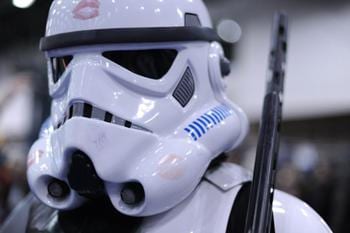This past month I had the privilege of attending the New York Comic Convention, which is, apparently, now one of the biggest comic cons in North America. The New York Comic Con was my sixth comic event of the year, and just about every one has been different.
Indie cons like the Small Press Expo (in Bathesday, Maryland), Musuem of Comic and Cartoon Art Festival (also in New York City), and Toronto’s Toronto Comic Arts Fair or TCAF (sounds like decaf), are essentially larger versions of the craft fairs and zine fests I’ve been going to since I was in university. There are tables of mild-mannered indie creatures in wilting sweaters and vintage (-looking) T-shirts selling their print and fabric wares. You see a lot of vintage eyewear and homemade buttons at these things. I almost always leave these fests feeling like I need a new purse.
The larger cons I’ve been to are typically in warehouse-type spaces like Toronto’s Exhibition Centre, which houses the Paradise Comic Con. These are often a bit more packed and a bit sweatier than the indie versions (as a side note, I feel like this would not be so if we all agreed to just give ourselves a little deodorant and a little personal space — just saying). I typically feel, at these larger cons, like I should pack a snack in case I get lost or feel hungry and don’t want to pay $20 for a slice of what looks like but doesn’t taste like pizza.
The New York Comic Con, however, made all the cons I’d attended previously seem like quaint Thanksgiving dinners. The sheer size of the event, held in New York’s Jacob Javits Center, was hard to comprehend. It was big like New York is big. I’m sure at least one family lost a small child in the throngs of attendees dressed up like characters from books and movies. Just about any costume/character you would guess would have been there, was there: there were several Star Wars Stormtroopers, at least one Wookie, some disheveled Ghostbusters and too many manga characters to count and catalog. There were a staggering number of vinyl/polyester pantsuits, matched with giant superhero-looking belts, which made me wonder if there is some place out there where you can purchase said suits. If so I think I would like a black vinyl pantsuit with a big red belt, please.
Although I had almost no queer purpose at the Con, the two big purchases that I arrived at the event planning to buy were comic stories that I love, I think in part, because of their queer story lines. Both published by Oni Press, Ross Campbell’s Wet Moon series and Bryan Lee O’Malley’s Scott Pilgrim series are comics that feature queer characters chucked in amongst a host of non-queers. I’m sure I love them in part because of how well they’re written, in part because they sometimes feature some nice making out.
When I say I had no queer purpose at the Con, I could almost add that there wasn’t really any sense of queer purpose at the Con. One thing I have noted in the past with all my comic con experiences is how unqueer these events feel to me. They don’t feel homophobic, although truly there is a strong sense of boy meets girl in many of the classic comics that paper the psychic walls of these places, it’s more that there’s this absence. Like if you were to walk up to someone and say, “homo?” They’d just shrug and give you a sticker for a movie about a witch.
Beyond this, even in the discussions that I’ve heard in the panels and workshops at these conventions, talk of queers doesn’t happen very often if at all. Part of that is my bad. At the New York Comic Con I was on a panel on the Representation of Women In Comics and none of us, not even me, talked about queerness, in a conversation about representation. I say this is my bad because typically I make it my responsibility to bring “queer” up, but I was too busy shooting my mouth off about the lack of chub in comics. I kind of plum forgot about queer.
On the bright side, I should add, the best thing about cons is that even if they’re not very queer, there’s tons of queer potential at these things. I mean, seriously, everyone is dressed up! Boys are in tights! In the cafeteria level below the main floor, there were hordes of kids — boys and girls — with extensive make-up kits tracing each other’s faces with eyeliner. It would have felt very drag if only there was a little music, instead of just the hum of the Playstation mega booth upstairs. God, I thought several times as I wandered around breathing in the familiar smell of cold cream and sweaty fishnets, we are so close and yet so far.
Is the answer that we need more queer superheroes, or just more happy queers at cons? I’m not sure. I will, however, be at TCAF this May and I am going to be dressed in a custom pantsuit, possibly carrying a small boombox, blasting disco. I’m going to see how that goes and then I’m going to the motherload Comic Con in San Diego in drag. If anyone wants to tag along, pop me an email.
Lets take the city.

 Why you can trust Xtra
Why you can trust Xtra


